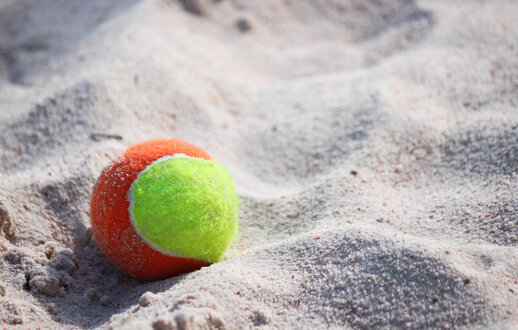BEACH TENNIS EQUIPMENT
the equipment you need to get up and running playing beach tennis is pretty simple. as long as you have racket and a ball you can get started. the net and the court, whilst great to have when you begin to play more seriously and want to play competitively, at the very start of your learning, just a paddle racket and a ball is all you need.
the beach tennis racket

a beach tennis racket is not like a standard tennis racket. in beach tennis we play with stringless paddle rackets, they have holes puncturing the surface which allow to air to flow through so the movement of the racket through the air is smooth. there are a number of manufacturers of beach tennis paddle rackets. adrenaline beach tennis are pleased to have dropshot uk as our official beach tennis racket partner in 2022. we stock a range of Dropshot rackets which can be viewed and purchased in our online shop. as rackets vary in length, weight and composition we also endeavour to have demo rackets available at our weekly sessions so that you can try before you buy, ensuring the purchase is the right one for you.
THE beach tennis BALL

Although a beach tennis ball is the same size and is made from the same substance as a regular tennis ball, a beach tennis ball is in fact a stage two orange tennis ball and is decompressed by 50% which means it moves 50% slower than a regular tennis ball. The decompression is critical to ensure that players can maintain control when using a stringless racket whilst at the same time encouraging longer rallies which makes for a more interesting and challenging sport. The ITF are currently trialling a purple and orange stage 2 tennis ball which they hope will improve sighting the ball during sunny daylight play.
the beach tennis court

the surface of a beach tennis court is sand. the itf regulations require a depth of 25cm and the sand is typically a blend of course and fine sand that is very
soft, won’t compact and produces very little dust and the dimensions of a beach tennis court are exactly the same as a beach volleyball court, 16m x 8m. the fundamental difference between a beach tennis court and beach volleyball court is the net. firstly the holes in a beach tennis net are much smaller due to the difference in the size of a beach tennis ball as compared to a beach volleyball, tennis balls can pass through the holes in a beach tennis net, so the smaller holes provide the barrier needed. secondly and perhaps more importantly the height of the net is much lower in beach tennis. the standard height of a beach tennis net is 1.7m. it’s also worth noting that in 2020/2021 the itf are testing a net height increase in the men’s game to 1.8m.
THE BASIC RULES of beach tennis
- it’s all about the volley – the ball is not allowed to touch the sand/ground – so its simple – just serve and volley!!
a point is won if the ball hits the ground in the opposing court or if the opponents hit (or serve) the ball out or into the net.
under and overarm serves are permitted, although in mixed doubles the men must serve under arm
there is no let when serving
a player can serve to any part of the court, but must stay behind the baseline when serving
service receivers must be 3 metres from the net when the ball is served – known as the no block zone.
any person not on the serving team can return the serve
the same scoring system is used as for regular tennis, with the following exceptions; there is no advantage after deuce, there is no second service, there is no service let
predominantly played in doubles format but there is a singles format
if the ball hits any part of the line in anyway the shot is good and considered “in”
no part of a player’s body or their equipment may touch the net or cross the plane of the net, either over o
No part of a player’s body or their equipment may touch the net or cross the plane of the net (over or under). If it does, that team will lose the point being played
Only one hit is permitted to get the ball over to opposing court
